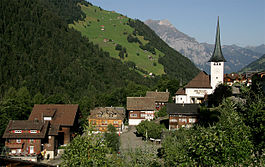Spiringen
Spiringen | |
|---|---|
 | |
| Coordinates: 46°52′N 8°44′E / 46.867°N 8.733°E | |
| Country | Switzerland |
| Canton | Uri |
| District | n.a. |
| Area | |
| • Total | 64.68 km2 (24.97 sq mi) |
| Elevation | 923 m (3,028 ft) |
| Population (31 December 2018)[2] | |
| • Total | 849 |
| • Density | 13/km2 (34/sq mi) |
| Time zone | UTC+01:00 (Central European Time) |
| • Summer (DST) | UTC+02:00 (Central European Summer Time) |
| Postal code(s) | 6464 |
| SFOS number | 1218 |
| ISO 3166 code | CH-UR |
| Surrounded by | Bürglen, Glarus Süd (GL), Muotathal (SZ), Schattdorf, Unterschächen[3] |
| Website | www SFSO statistics |
Spiringen is a village and a municipality in the canton of Uri in Switzerland. The municipality comprises two disjoint areas, separated by the municipality of Unterschächen and the Klausen Pass. The western area includes the village of Spiringen in the Schächen Valley, whilst the eastern area includes the Urner Boden alp above Linthal and the canton of Glarus.[3]
Geography
Spiringen has an area, as of 2006[update], of 64.7 km2 (25.0 sq mi). This area is split into two parts, with the slightly smaller part around the village of Spiringen in the valley of the Schächen, which drains westward towards the Reuss and Lake Lucerne. This part is surrounded by the municipalities of Bürglen and Schattdorf to the north and west, and the municipality of Unterschächen to the east and south. Some 8 kilometres (5.0 mi) away, on the eastern side of Unterschächen and the Klausen Pass, is the second and larger part of the municipality. This comprises the Urner Boden meadows, and drains eastward into the Linth and Lake Zürich. Besides Unterschächen to its west, this part is surrounded on its north by the municipality of Muotathal in the canton of Schwyz, and on its south and east by the municipality of Glarus Süd in the canton of Glarus.[3][4]
Of the total area of the municipality, 37.5% is used for agricultural purposes, while 17.6% is forested. Of the rest of the land, 1.4% is settled (buildings or roads) and the remainder (43.5%) is non-productive (rivers, glaciers or mountains). In the 1997 land survey[update], 11.7% of the total land area was heavily forested, while 3.2% is covered in small trees and shrubbery. Of the agricultural land, 0.0% is used for farming or pastures, while 8.5% is used for orchards or vine crops and 29.0% is used for alpine pastures. Of the settled areas, 0.5% is covered with buildings, and 0.7% is transportation infrastructure. Of the unproductive areas, 0.1% is unproductive standing water (ponds or lakes), 0.9% is unproductive flowing water (rivers), 32.6% is too rocky for vegetation, and 10.0% is other unproductive land.[4][5]
Demographics
Spiringen has a population (as of 31 December 2020) of 842.[6] As of 2007[update], 0.9% of the population was made up of foreign nationals. Over the last 10 years the population has decreased at a rate of -11.6%. Most of the population (as of 2000[update]) speaks German (99.8%), with Italian being second most common ( 0.2%) and Sd being third (gdsD%).[4] As of 2007[update] the gender distribution of the population was 51.8% male and 48.2% female.[7]
In the 2007 federal election the FDP party received 91.3% of the vote.[4]
In Spiringen about 37% of the population (between age 25-64) have completed either non-mandatory upper secondary education or additional higher education (either university or a Fachhochschule).[4]
Spiringen has an unemployment rate of 0.34%. As of 2005[update], there were 194 people employed in the primary economic sector and about 88 businesses involved in this sector. 38 people are employed in the secondary sector and there are 8 businesses in this sector. 78 people are employed in the tertiary sector, with 19 businesses in this sector.[4]
The historical population is given in the following table:[8]
| year | population |
|---|---|
| 1970 | 946 |
| 1980 | 943 |
| 1990 | 921 |
| 2000 | 963 |
| 2005 | 943 |
| 2007 | 909 |
References
- ^ a b "Arealstatistik Standard - Gemeinden nach 4 Hauptbereichen". Federal Statistical Office. Retrieved 13 January 2019.
- ^ "Ständige Wohnbevölkerung nach Staatsangehörigkeitskategorie Geschlecht und Gemeinde; Provisorische Jahresergebnisse; 2018". Federal Statistical Office. 9 April 2019. Retrieved 11 April 2019.
- ^ a b c map.geo.admin.ch (Map). Swiss Confederation. Retrieved 21 April 2015.
- ^ a b c d e f Swiss Federal Statistical Office accessed 9 September 2009
- ^ Canton Uri - Ground use statistics Template:De icon accessed 8 September 2009
- ^ "Ständige und nichtständige Wohnbevölkerung nach institutionellen Gliederungen, Geburtsort und Staatsangehörigkeit". bfs.admin.ch (in German). Swiss Federal Statistical Office - STAT-TAB. 31 December 2020. Retrieved 21 September 2021.
- ^ Uri Population statistics Template:De icon accessed 8 September 2009
- ^ Uri in Numbers 2009/10 edition Template:De icon accessed 8 September 2009




